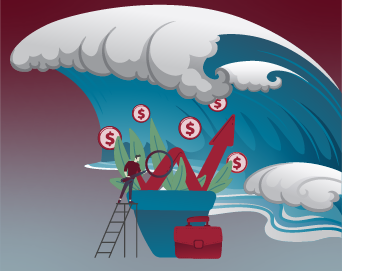4 Ways Investing in Supply Chain Research Benefits the Bottom Line

March 5, 2020 | By Marat Davletshin
Imagine you run a public company with dozens of suppliers. Of these suppliers, several are essential to consistently deliver excellence to the retailers that sell your products and the customers who buy and use them.

Everything is great. Your company’s financials are strong, and the stock price is trending upward. That is, until the day when a highly respected stock analyst issues a negative report on your company. The reason? A supplier in Indonesia is financially weak and expected to go out of business. You’ve never heard of this manufacturer, but you discover it supplies a specialized part to a manufacturer in New Zealand. The manufacturer uses that part in a product that’s then used by one of your key suppliers in the United States. Your U.S. supplier has no backup plan, which means it will likely underperform. As a result, so will your company. The ripple effect will hit you like a wave you never saw and couldn’t control.
What if you knew about the Tier 4 supplier’s trouble in time to mitigate the issue? What if you were truly managing your supply chain – the full network, not just your direct suppliers – so well that when the analyst called to ask questions about the company in Indonesia, you responded with a plan that’s already in the works? Your foresight would strengthen your company’s value in the eyes of the analyst. You would ride that wave like a veteran surfer.
How would you know? The same way the stock analyst knew: by digging deeply into your supply network to understand how every company is connected and related.

Stock analysts spend hours devouring information about one or two companies. They have a simple but difficult end-game in mind – to predict the future. Their success depends on their ability to find and make sense of the most relevant data that will tell them (and then investors) how well a company will likely perform in the coming months and years. There was a time when they primarily got their information from company reports, by talking to corporate leaders and by questioning competitors and customers. More and more, however, they have learned the importance of understanding the complex relationships in a company’s supply network.
While working on my doctorate in supply chain management at the Sam M. Walton College of Business, I interviewed more than a dozen stock analysts. I found a common thread in comments such as these:
- “I spent several weeks in China to study an important Tier-3 supplier and its connections.”
- “We think in terms of networks. … We want to know the ecosystem.”
- “In Canada, forests belong to the government. I spent months studying Canadian laws to understand how a relationship with a Tier-2 Canadian pulp supplier may influence a U.S. paper manufacturer.”
C-suite executives often suggest that deep analytics into supply networks is overly complicated and time-consuming. They do not think it's worth the investment. But, as the stock analysts confirm, there’s tremendous value in that type of research. For instance,
- A supply network mediates the influence of a firm’s environment on the firm’s outcomes.
- The outcomes of any firm depend not only on its own performance, but also on the performance and outcomes of many other directly and indirectly connected parties.
- Revenues, profits, stock returns of economically linked firms are correlated.
- Effects of disruptions, quality problems, environmental and social issues, and financial distress diffuse throughout a supply network.
Think of a supply network as pipes through which physical goods, money and information flow like water. This is unlike a house, which has one water pipe connecting it to the water supply. A company is more like a giant swimming pool with dozens of pipes connecting it to different suppliers. Dirty water coming into the pool from only one of these pipes will make the entire pool dirty, even though the rest of the pipes are fine. That dirt can arrive from a far-away source, making the company dependent on the “health and cleanliness” of places that may be only indirectly connected to “the pool.”
No matter how thoroughly you clean your pool (your own performance), dirty water from one of the pipes will make your pool less clean (you depend on the cleanliness at your water sources and your sources’ sources).
In addition to physical goods, money, and information, there may be some bad stuff flowing through the system. The effects of disruptions, quality problems, environmental and social issues at one supplier can travel throughout a supply network.
The takeaway: it pays to know your supply network deeper inside!

The cleanliness of your pool depends on the cleanliness of many other sources. So to your revenues and profits can depend on the financial health of suppliers you’ve never heard of. For example, many patients who contracted the coronavirus had never heard of Wuhan, the virus’s origin.
Many of the barriers to this type of analytics have fallen in recent years. This is thanks to advancements in technology and a greater understanding of network theory. In fact, my research shows that companies can effectively see and manage seven tiers back into their supply chain. There now is empirical evidence that network theory allows us to plot and show the dynamic and complex relationships between companies that are connected across a supply network. This allows us to identify strengths, weaknesses, and key influencers that add data and insights to the discussions about a company’s health.

Stock analysts aren’t yet fully applying network theory in their work, but they do understand the importance of digging deeper into the connections that form a supply network. That type of knowledge gives them a competitive advantage. And if it gives them a competitive advantage in predicting the performance of a company, it only makes sense for C-suite executives to seek that advantage as well.

